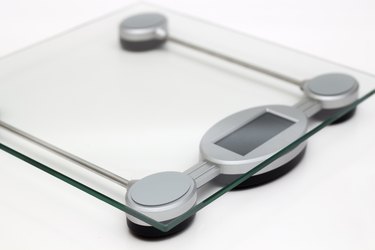
The use of digital body composition analyzers has increased in popularity to assess healthy weight in both the medical field and fitness industry. Body composition, also known as body fat percentage, is a more accurate predictor of healthy weight than the number of pounds on the scale as stand alone data. The ratio of muscle-to-fat is the true measure of healthy weight and predictor of potential health risks. These assessment devices can be used in a variety of professional and personal settings due to their portable and non-invasive design.
Types
Video of the Day
Two popular manufacturers of body fat analyzers using bioelectrical impedance analysis (BIA) are Omron and Tanita. Both companies offer a range of products that are user friendly and meet the needs of variety of populations in technology as well as price. The validity of such tools has been tested and reviewed in scholarly publications along with popular websites and magazines. Prices vary greatly from retailer to retailer so take some time to do your research because it pays off.
Video of the Day
Omron
The Omron brand of devices seem to rate better in consumer reviews as well as peer reviewed journal publications in comparison to the Tanita brand. In a 2002 study published in Medicine and Science in Sports and Exercise, the Omron HBF300 device fared better when analyzing a multiracial active female population than the Tanita 02701001 scale. The ages of participants ranged from 18-59 years and were varied in their preferred mode of exercise.
Newer models offer hand to foot sensors which offer more accurate readings than foot-to foot technology. Omron models also measure 5-7 fitness indicators including BMI, body weight, body fat, muscle mass, resting metabolic rate and body age.
Tanita
The most common complaint about the Tanita brand is that the measurements for body fat were not consistent. However, the measurements body weight were. Tanita offers a line of products in partnership with Ironman, which serves a more athletic population. Depending on the model, the scales measure weight, body fat percentage, BMI, BMR, visceral fat, muscle mass, bone mass and metabolic age.
Benefits
The great thing about using a body fat analyzer such as an Omron or Tanita scale is that it is easy, non-invasive and anyone can operate it. Unlike the skin fold calipers or laboratory tests such as a DEXA scan and hydrostatic weighing, stepping on a scale can be done by everyone. Depending on the model you chose, these scales can accommodate individuals up to 440 lbs.
Considerations
Drawbacks include level of hydration at time of weigh in, accuracy of measurement, validity of data based on the demographic of the population using the scale in contrast to the equation used for calculation in the device and the fitness level of the user. There is a tendency for these devices to overestimate for leaner individuals and underestimate for individuals with a greater fat mass. The use of these devices is not recommended for pregnant women or those with pacemakers or internal electronic medical equipment.
- Comparison of Tanita and Omron Bioimpedance Estimates Of Relative Fatness In Physically Active
- Bioelectrical Impedance Analysis
- Body Composition Monitors for Home Use
- Tanita Body Fat/Body Water Monitor BF-680W
- Accuracy of Bioelectrical Impedance Consumer Devices for Measurement of Body Composition in Comparison to Whole Body Resonance Imaging and Dual X-ray Absorpitiometry